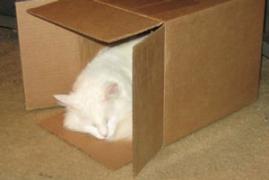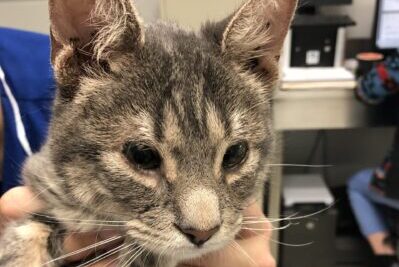Pet Stress Busters

Pet Stress Busters
In my last blog, I wrote about some of the situations that cause stress in pets. Today I will share my suggestions for relieving their stress.
Natural remedies
In addition to having adequate litter boxes and feeding special diets to control stress-related diarrhea mentioned in my last blog, the concerned pet owner can respond with environmental enrichment, exercise, and natural destressors, such as pheremones. When I have hospitalized feline patients at The AMC, I like to give them a cardboard box in their cage for hiding. I spray the box with Feliway, a feline pheromone, which signals comfort and reassurance to the cat.
Dogs have their own pheromone for stressful situations, called DAP. I find spraying it on a bandana and placing it around the dog’s neck often calms a dog stressed by travel or a clinic visit.
The popularity of lavender in candles, soaps and lotions is in part due to its natural stress reductions properties. One of my patients, a nervous terrier named Fred, benefitted from lavender oil daubed on the tips of his ears at the beginning of a clinic visit. This simple, safe stress buster immediately stopped Fred’s shaking and calmed him enough that he would snooze while I spoke with his family.
An intriguing new product is Pet Naturals of Vermont’s Calming for Pets treats for cats and dogs. This product contains natural ingredients to support stress reduction and comes in a variety of sizes to fit your pet. Last week I tried some on my patients who enthusiastically give these bone-shaped treats an all paws up rating.
Environmental enrichment
Providing an enriched environment helps to combat stress and is one way of providing activities other than lying on a sofa.
Challenge your pet with puzzle toys for feeding. Food puzzle toys will amuse your pet and will simultaneously help to control their weight by slowing their rate of eating. These puzzles are available for both dogs and cats at nearly every pet emporium.
Water fountains provide entertainment for your cat or dog and will encourage adequate water consumption for those pets with medical conditions requiring increased water intake.
Fresh air and sunshine improve everyone’s mood, cats included. If taking your pet outside is difficult, make sure it has a safe perch on a window ledge or piece of furniture so it can look beyond the four walls. Cats love to perch and if you do not have a good view from your windows, try a cat tower to add perching opportunities to your home.
What are your suggestions for decreasing stress in your pet? Please share them in the comments section below.
________________________________________________________
This may also be found in the “Tales from the Pet Clinic” blog on WebMD.com.
For over a century, The Animal Medical Center has been a national leader in animal health care, known for its expertise, innovation and success in providing routine, specialty and emergency medical care for companion animals. Thanks in part to the enduring generosity of donors, The AMC is also known for its outstanding teaching, research and compassionate community funds. Please help us to continue these efforts. Send your contribution to: The Animal Medical Center, 510 East 62nd Street, New York, NY 10065. For more information, visit www.amcny.org. To make an appointment, please call 212.838.7053.


































